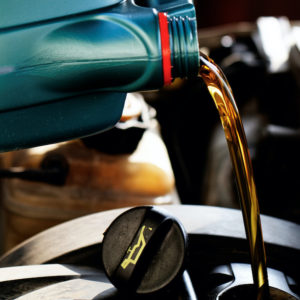When you go shopping for engine oil, you’ll likely run across a variety of grades, including 5W-30 and 5W-40. What’s the difference between these two products—and which should you put in your car?
Let’s find out.
What’s an Engine Oil Viscosity Grade?
Before we go any further, it’s important to discuss engine oil viscosity grades. The grades are defined by the Society of Automotive Engineers (SAE) and listed on the oil container. Each grade indicates a specific viscosity characteristic and range.
Viscosity refers to an oil’s thickness and, therefore, its resistance to flow. Engine oil that is thinner flows more easily than thicker oil. Also, the thickness of the oil changes with temperature (oil is thicker when it’s cold).
When you look at a bottle of multi-grade oil, you’ll notice the viscosity grade contains two numbers and a ‘W’. For example, the oil might have a viscosity grade of 5W-30.

Here’s what the viscosity grade means:
- The first number is the oil’s cold weather viscosity grade
- The ‘W’ stands for winter
- The third number is the oil’s hot weather viscosity grade
The larger the viscosity numbers are, the thicker the oil and the greater its resistance to flow. For instance, 5W-30 oil is thicker than 5W-20.
It’s worth noting that there are also single-grade oils that only have one number. An example would be SAE 20 oil or 30W oil. Such oils have a narrow viscosity range and are not suited for modern automotive applications.

5W-30 Oil vs. 5W-40 Oil
Now that you understand oil viscosity, you probably have an idea of the difference between 5W-40 oil and 5W-30 engine oil. Although both have the same viscosity grade in cold weather, 5W-40 is thicker than 5W-30 at warmer temperatures.
It’s also worth pointing out that:
- 5W-40 is the suggested oil for most diesel applications. Rarely (if ever) do vehicle manufacturers recommend putting 5W-40 oil in a gas-powered engine.
- 5W-30 oil is the recommended oil for many modern gasoline applications.

5W-30 Oil vs. 5W-20 Oil
You might also be wondering, “What’s the difference between 5W-30 and 5W-20 oil?” 5W-20 oil is also a common oil found on store shelves after all.
The 5W-30 oil is thicker when the engine is hot, which protects the engine’s parts better during heavy use. Meanhile, 5W-20 oil is thinner at high temperatures, which improves fuel efficiency and aids in starting the car in colder weather. Because 5W-20 oil is thinner, it reduces resistance in the engine and improves gas mileage.
5W-30’s thickness at higher temperatures makes it more suited for older engines or engines running in difficult conditions. It’s ultimately better in warmer climates, but 5W-20 oil shines in colder places, as it flows better at lower temperatures.
Common Oil Viscosity Misconceptions Corrected
There are a few common misconceptions regarding oil viscosity that you must watch out for and ignore. Here are the real facts behind these myths:
Firstly, thicker oil doesn’t always provide better protection. Thicker oils increase resistance, which can make it harder for the oil to flow in cold weather. This leads to bad lubrication, reduced fuel efficiency, and increased engine wear.
Second, not all viscosities will work in any climate. Oil viscosity isn’t universal. Thicker oils will have a more difficult time circulating in the engine in colder climates, which can cause poor lubrication during start-ups. Thinner oils, on the other hand, break down more easily in extreme heat.Finally, oils with higher viscosity aren’t always the best choice for high-mileage engines. It’s true that thicker oils can help with minor leaks and oil consumption in older engines, but they won’t solve everything. Oils that are too thick can strain the engine, which can cause issues during cold starts and reduce the engine’s efficiency. Be sure to use a high-mileage oil that’s specifically formulated for the engine’s needs.
Which Grade of Oil is Correct for Your Car?
There are two ways to determine the correct engine oil for your car. The first option is to look the information up in your owner’s manual. Another way is to look at the oil fill cap on top of the engine.
You should use the type of oil the vehicle manufacturer recommends for your car, regardless of whether that’s 5W-30, 5W-40—or something else altogether. Using the incorrect type of oil can cause engine performance problems and trigger the check engine light. The practice can even accelerate engine wear and eventually cause internal damage.
The only time you might consider deviating from the oil the vehicle manufacturer recommends is when your car’s engine already has internal problems. If the engine is suffering from increased internal clearances due to wear, choosing a higher viscosity may compensate for those clearances enough to limp the engine along for a short while. But you should only attempt this method on an engine that’s already headed for the scrapyard.
In every other instance, you should use the type of oil the vehicle manufacturer recommends. Doing so will keep your engine running better, longer.
Any information provided on this Website is for informational purposes only and is not intended to replace consultation with a professional mechanic. The accuracy and timeliness of the information may change from the time of publication.































